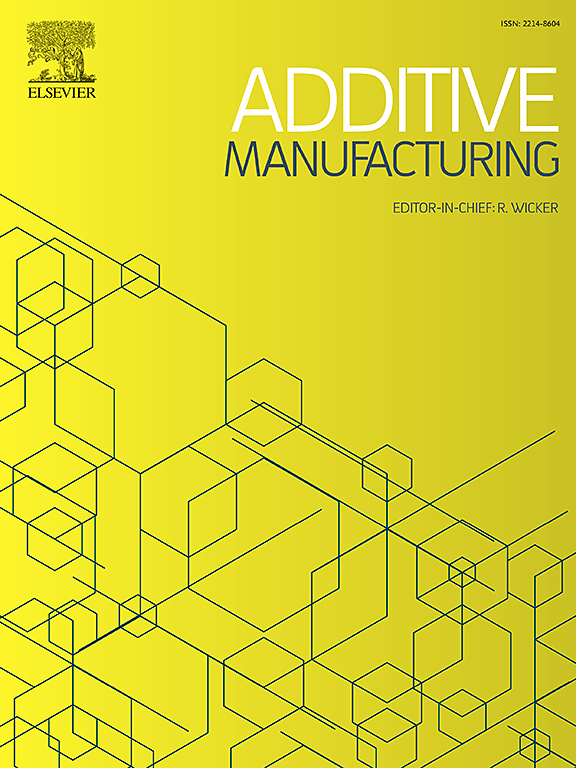I-wi: Multifunctional 3D-printable stretchable ionogel and ionic eutectogel wires with AC and DC signal transmission
IF 10.3
1区 工程技术
Q1 ENGINEERING, MANUFACTURING
引用次数: 0
Abstract
Recent advances in technologies based on soft matter functionality have spurred the demand for flexible and stretchable conductors. However, state-of-the-art stretchable conductors suffer from trade-offs between material compositions, design and scale factors, electrical properties, durability, and precise fabrication methods, thus sacrificing critical parameters and hindering performance. The longstanding challenge in the field has been co-developing reliable, stretchable, and highly electrically conductive bulk elastomers with precise fabrication methods for transferring diverse signals over distances, while both at rest and in a stretched state under both DC and AC conditions. In this study, we developed, characterized, and showcased i-wi (ionic wires) — soft, stretchable, and 3D-printable ionogels and ionic eutectogels designed for applications in soft stretchable electronics under both DC and AC. We combined imidazolium-based ionic liquids (ILs) or ethaline and glyceline deep eutectic solvents (DESs) with photopolymer compositions to obtain ionogels or eutectogels, respectively, that combine elastic deformation with high ionic conductivity and that can be precisely 3D-printed using the vat photopolymerization method. We showed that i-wi can transfer both DC and AC signals in various implementation scenarios, extending the horizon for myriad applications. We demonstrated the multifunctionality of i-wi in multimaterial connectors, which conducted signals to light LEDs, play music, and perform electric guitar, while both at rest and under stretching, and which functioned as precise temperature and strain sensors. We suggest that i-wi may become a core component of physically intelligent systems, including morphological computing, advanced wearable and medical devices, and the broader field of soft robotic systems.
I-wi:具有交直流信号传输功能的多功能 3D 打印可拉伸离子凝胶和离子共晶凝胶导线
基于软物质功能的最新技术进步刺激了对柔性和可拉伸导体的需求。然而,最先进的可拉伸导体在材料成分、设计和规模因素、电性能、耐久性和精确的制造方法之间存在权衡,因此牺牲了关键参数并阻碍了性能。该领域长期面临的挑战是共同开发可靠、可拉伸、高导电性的体弹性体,并采用精确的制造方法,在直流和交流条件下,在静止和拉伸状态下传输不同距离的信号。在这项研究中,我们开发,表征和展示了i-wi(离子线)-柔软、可拉伸、可3d打印的离子凝胶和离子共凝胶设计用于直流和交流下的软可拉伸电子器件。我们将咪唑基离子液体(ILs)或乙炔和甘油深共晶溶剂(DESs)与光聚合物组合物相结合,分别获得了结合弹性变形和高离子电导率的离子凝胶或共凝胶,并且可以使用还原光聚合方法进行精确的3d打印。我们证明了i-wi可以在各种实施方案中传输直流和交流信号,扩展了无数应用的范围。我们在多材料连接器中展示了i-wi的多功能,它可以在休息和拉伸时向发光led传导信号,播放音乐和演奏电吉他,并且可以用作精确的温度和应变传感器。我们认为,i-wi可能成为物理智能系统的核心组成部分,包括形态计算、先进的可穿戴设备和医疗设备,以及更广泛的软机器人系统领域。
本文章由计算机程序翻译,如有差异,请以英文原文为准。
求助全文
约1分钟内获得全文
求助全文
来源期刊

Additive manufacturing
Materials Science-General Materials Science
CiteScore
19.80
自引率
12.70%
发文量
648
审稿时长
35 days
期刊介绍:
Additive Manufacturing stands as a peer-reviewed journal dedicated to delivering high-quality research papers and reviews in the field of additive manufacturing, serving both academia and industry leaders. The journal's objective is to recognize the innovative essence of additive manufacturing and its diverse applications, providing a comprehensive overview of current developments and future prospects.
The transformative potential of additive manufacturing technologies in product design and manufacturing is poised to disrupt traditional approaches. In response to this paradigm shift, a distinctive and comprehensive publication outlet was essential. Additive Manufacturing fulfills this need, offering a platform for engineers, materials scientists, and practitioners across academia and various industries to document and share innovations in these evolving technologies.
 求助内容:
求助内容: 应助结果提醒方式:
应助结果提醒方式:


